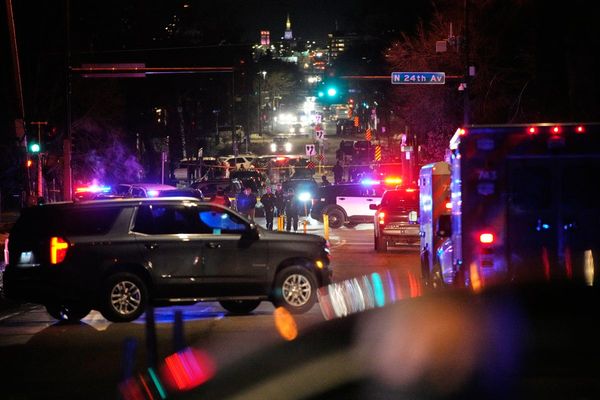A shark swimming down a flooded road. A bunch of missiles blasting off in unison during an Iranian missile test.
At first glance they might seem reasonable, but digitally altered images are everywhere, spreading like wildfire on news sites and social media.
So how can you tell if that photo your uncle shared on Facebook is authentic or has been manipulated?
Image forensic experts have a few tools to spot images that have been tinkered with.
Algorithms can spot cloned areas, like the extra Iranian missile inserted into a launch photo (although, just looking at it, that one is pretty obvious).
Other techniques include building a virtual 3-D model from scratch to analyse the way light falls on a scene.
But for the average person without access to these tools, nor the skills or time to properly pick apart dodgy-looking images, there are a few basic things we can do, said Hany Farid, a computer scientist and digital forensics expert at Dartmouth University in the US.
Reverse image search
Let's start simple. When he sees an image pop up on Twitter or Facebook, Dr Farid likes to see if it's been on the internet before by doing a reverse image search, using Google Images or TinEye.
"Every time there's a natural disaster, people circulate the same silly images of sharks swimming down the street," Dr Farid said.
"Images of sharks are almost always fake."
If an image has been recirculated from another website, or repurposed for whatever disaster has most recently struck, they can be discovered with a reverse image search.
Better yet, you might find the image debunked on Snopes.com or another outlet.
Get image metadata
So a photo has passed the reverse image search. Next, try burrowing into its metadata — the swathe of information that's added to the photo by the camera.
"There are many websites where you can upload an image and it will strip out the metadata and show it to you," Dr Farid said.
This includes the make of the camera, time of day the photo was snapped and GPS coordinates, if that's enabled.
Better yet, if the image was opened in Photoshop and re-saved, it will tell you that too.
"When you edit an image, it adds its own little bit of metadata," Dr Farid said.
"Of course, that doesn't tell you that the image was manipulated, but … maybe that should give you pause."
You might also find a thumbnail — a small version of the original photo — saved with the image, said Richard Matthews, a PhD candidate researching digital image forensics at the University of Adelaide.
"All this happens in the background with you press the shutter," he said.
This won't work with all photos. Anything uploaded to Twitter and Facebook will have its metadata automatically stripped, which the companies say is for users' privacy.
Light and shadows
Time to crack out the ruler and a pencil: the next method is super low-tech.
Shadows and light can reveal objects that have been moved or popped into a photo.
Dr Farid, who studies the human visual system, found that if he showed people images with shadows that were not physically possible, they rarely noticed.
But this also means forgers are also unable to see inconsistent shadows too.
"If they drop an object into a scene, the shadow will be in the wrong place," he said.
"They don't notice, but the simple geometric construction is able to uncover it."
Basically, you rule a line from a point on an object to the corresponding point on its shadow. Do this for a load of points and the lines should converge on the light source.
For an outdoor scene, the lines can seem pretty much parallel, as the Sun is 150 million kilometres away.
Take the photo below on the left and the altered image on the right.
The person on the steps and her shadow were snipped out of a different photo and dropped in.
It doesn't look too bad — until you use the ruler method.
Red lines, joining her and her shadow, don't point to the same light source as the green lines drawn between objects and shadows in the rest of the scene.
Use photo or imaging editing software
If you suspect an object has been deleted from a image, software such as Photoshop or Pixlr can uncover telltale signs.
It relies on exaggerating very subtle differences that aren't usually visible. Even deep blacks contain a whole range of brightnesses, Dr Farid said.
"If someone goes in and erases something, you'll see a chunk of solid black, everything's missing," he said.
Check out this lovely summer Melbourne landscape. It's missing a couple of buildings on the right.
Play around with the contrast, brightness and exposure, and you start to see these solid colour blocks, suggesting something's missing.
What not to do
You might be enticed by online tools which claim to identify hoax images. Don't be sucked in, Dr Farid said.
"The fact is this stuff is pretty complicated and you really have to have a deep understanding of physics and optics and how cameras work and how compression works," he said.
Ah yes, compression. Most images online are compressed by JPEG — a "lossy" compression method.
It shrinks a file size by taking each eight-by-eight-pixel block in an image, processes them, and discards some of the information.
"The thing with JPEG is it introduces artefacts into the image and in particular, if you notice you have a particularly low-quality jpg image, you get what are called blocky artefacts," Dr Farid said.
These blocky artefacts — strong horizontal and vertical lines — can look a little like something's been added to or removed from an image.
On top of these, JPEG compression can produce colour distortions and blurring.
"You see all sorts of really weird things, and people often mistake those weird things for evidence of tampering. It's a classic mistake," Dr Farid said.
The eyes can also tell a story, Mr Matthews said. Zoom in on someone's pupils and they should reflect the light source.
"If it's a flash in a studio, you can see it in higher resolutions," he said.
If a group of people have been photoshopped together, reflections in their pupils might not all be the same … but Dr Farid exercises caution when it comes to eyes.
"It is possible that in a room there are different light sources," he said.
"If they're all consistent, that can tell you something useful. If they're different, though, the are other possible explanations," such as multiple flashes.
What about video?
Dr Farid's "a little worried" about realistic computer-generated videos.
"But when you dig in forensically, they're not even close to being able to fool a scientist," Dr Farid said.
Incredibly, an algorithm developed by computer scientists at Massachusetts Institute of Technology can pick up the subtle colour changes in a person's face as their heart pumps blood.
"A computer-generated person doesn't have a heartbeat. So when you do this to them, it's a literal flat line," Dr Farid said.
Of course, he added, this blood flush will be added to computer-generated videos in a few years, "but that's going to be the game".
"We develop a technique, they counter it," he said.
But he's confident that he and other digital forensics experts will be able to stay ahead of the game.
In the meantime, Dr Farid said the best defence against fake images and videos is to stop and think about their source before sharing them on social media.
"Think about how fast people digest digital content. Someone's rarely going to spend three hours analysing an image, even if they had the tools to do it," he said.
"For the love of God, if someone shares something on Facebook, would you please look at where it's coming from?"







